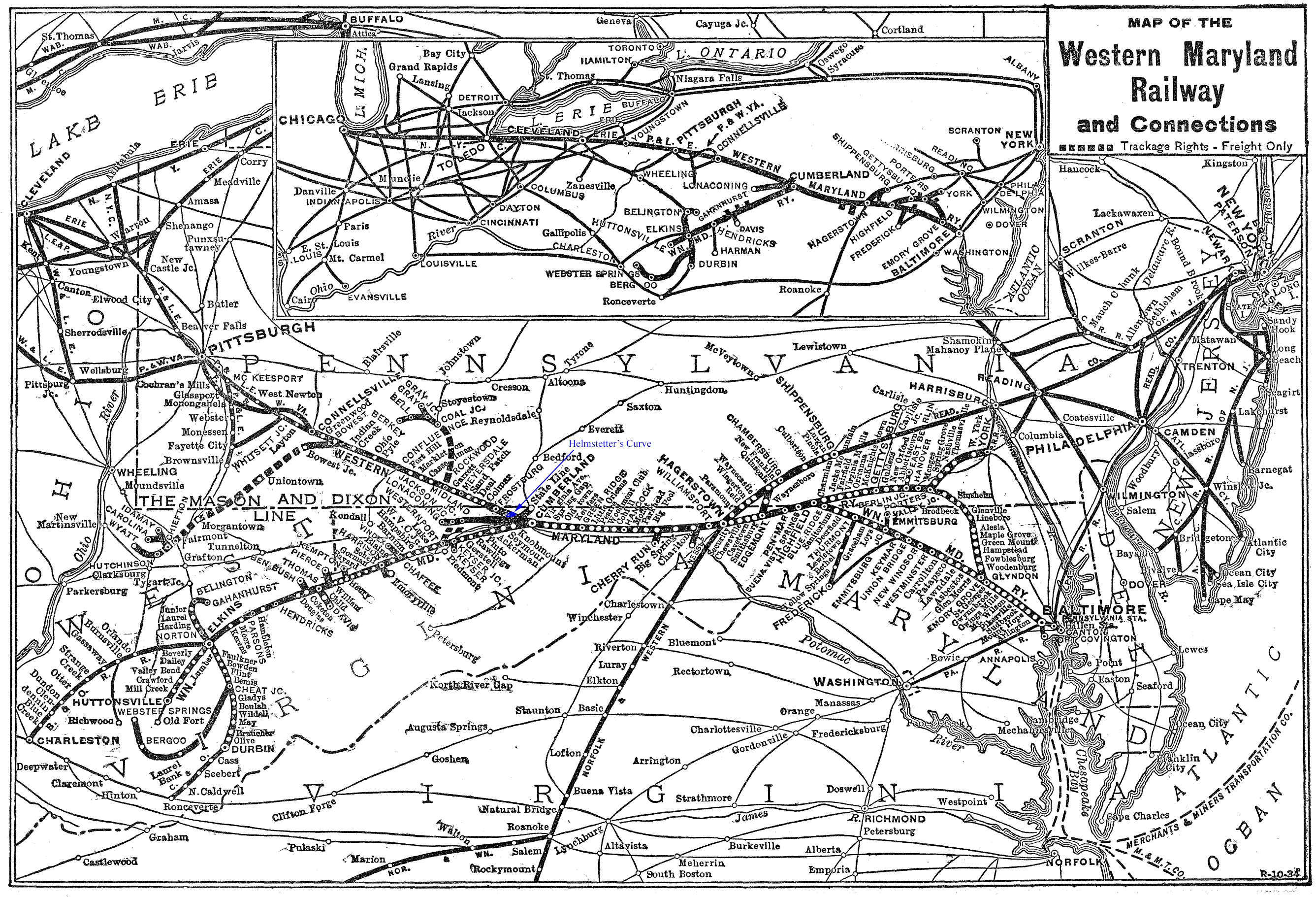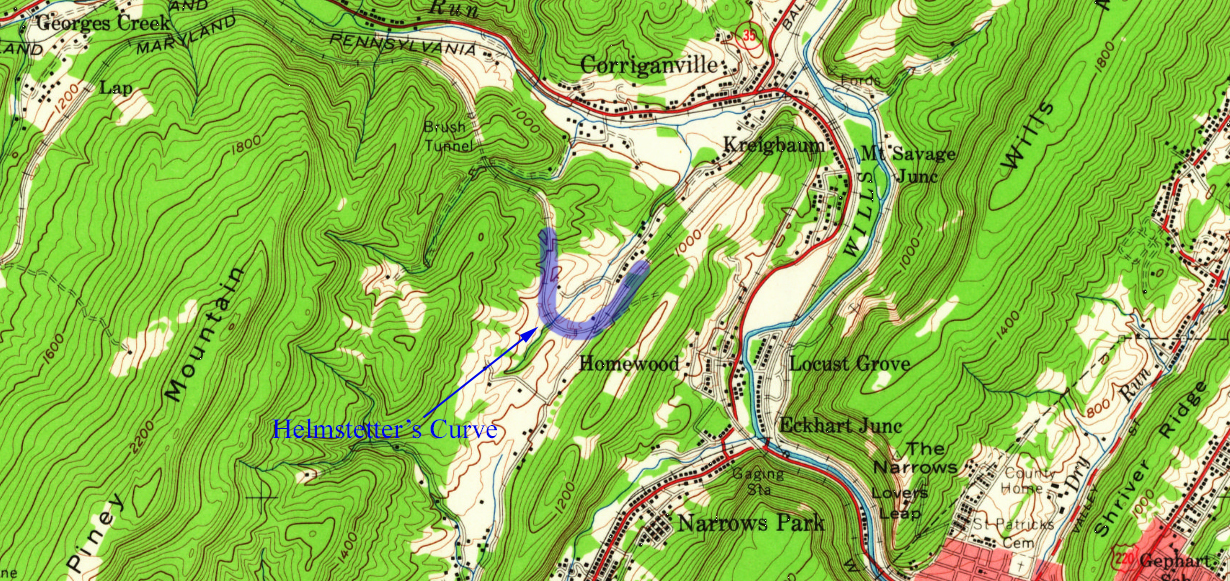Helmstetter's Curve (Western Maryland): Map, History, Photos
Last revised: August 24, 2024
By: Adam Burns
One of the most famous railroad landmarks east of the Mississippi River
is the Western Maryland's Helmstetter's Curve located just west of
Cumberland on the system's former Connellsville Subdivision.
As the company expanded westward in the early 20th century it had to find a relatively manageable gradient through the Allegheny Mountains which quickly rose once one was out of the Potomac River valley.
With newer engineering techniques, surveyors would ultimately plot a line that was somewhat easier than neighbor and competitor Baltimore & Ohio's Sand Patch grade. The curve became so well photographed over the years thanks to the generosity of the local family who owns the surrounding property and whose name is attached to it.
While sadly, much of the WM system has since been abandoned the curve today remains in regular use as part of the Western Maryland Scenic Railroad, not only giving visitors a chance to experience this magnificent location but also allowing photographers to continue to capture trains battling the climb.
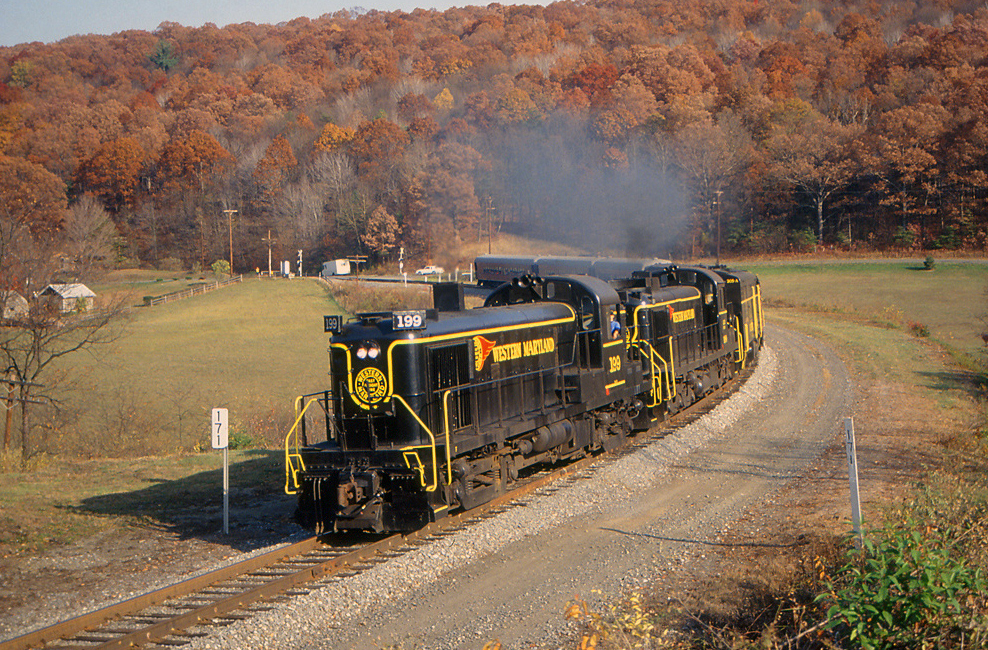 In a view that could certainly pass for the WM era, a trio of first-generation Alco road-switchers pull an excursion westbound through the curve along the Western Maryland Scenic Railroad at Corriganville, Maryland on October 26, 1991. Wade Massie photo.
In a view that could certainly pass for the WM era, a trio of first-generation Alco road-switchers pull an excursion westbound through the curve along the Western Maryland Scenic Railroad at Corriganville, Maryland on October 26, 1991. Wade Massie photo.History
The history of the Western Maryland Railway can be traced back to the Baltimore, Carroll & Frederick Railroad of 1852 chartered that year by the Maryland General Assembly.
The line was intended to connect the port of Baltimore with Washington County and to reflect this the assembly renamed the charter as the Western Maryland Rail Road Company in 1853. This new company had completed a line as far as Hagerstown by 1872 when it was renamed again as the Western Maryland Railway.
Construction continued southwestward as the WM gained control of the West Virginia Central & Pittsburg Railway by 1905 which gave it connections into the Mountain State's coal country as far as Elkins (a town that became a major southern division point for the railroad).
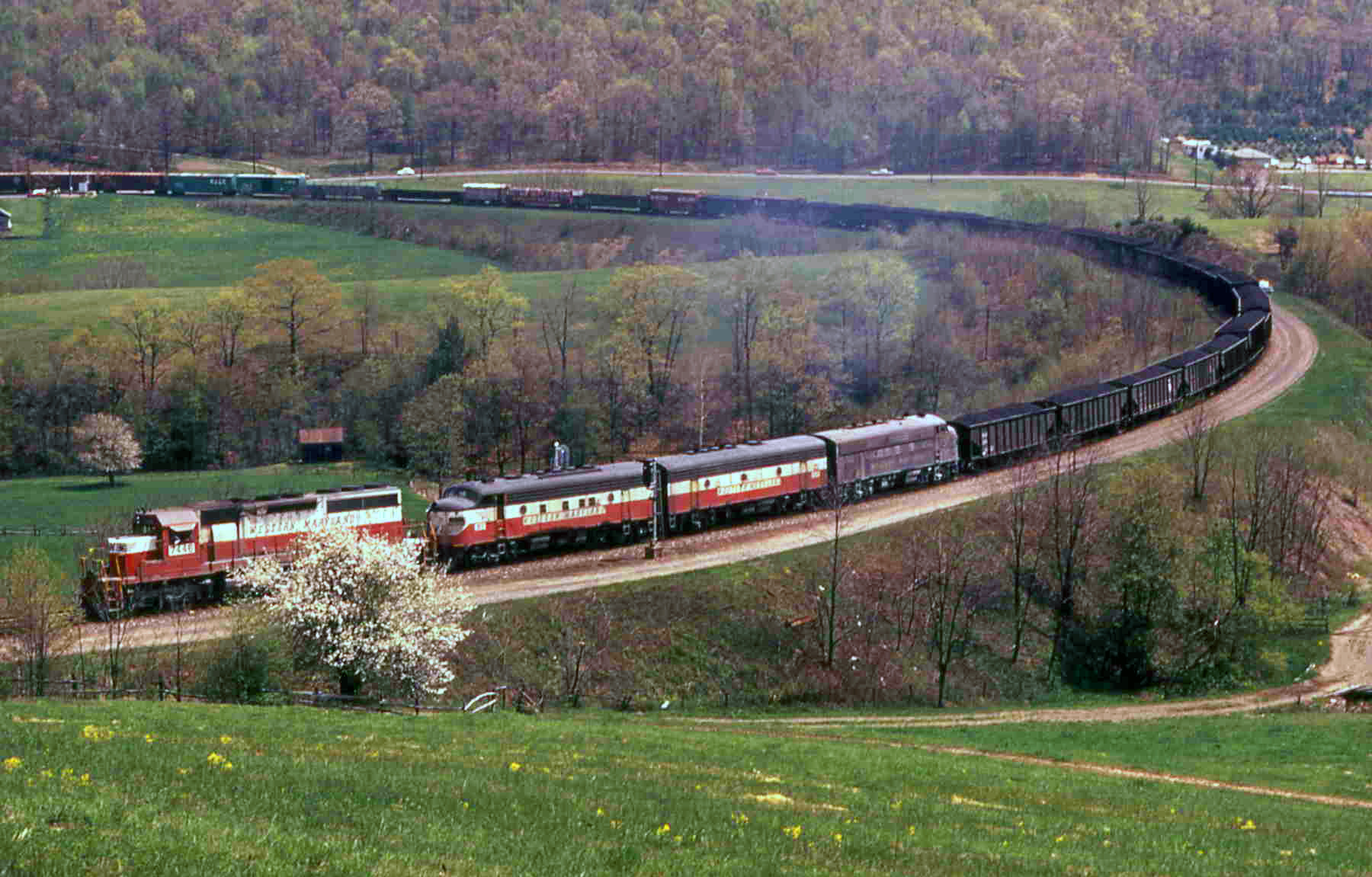 Taken during the late Western Maryland era, a westbound freight led by SD40 #7446 and three F7As rolls through the curve on May 11, 1975. This scene is significant as the last daylight westbound run over the Connellsville Extension. Paul Kutta photo.
Taken during the late Western Maryland era, a westbound freight led by SD40 #7446 and three F7As rolls through the curve on May 11, 1975. This scene is significant as the last daylight westbound run over the Connellsville Extension. Paul Kutta photo.George Gould
The company also continued to sprawl through northern Maryland and southern Pennsylvania thanks to acquisitions like the Baltimore & Hanover Railroad, Gettysburg Railroad, and the Potomac Valley Rail Road.
Also in 1902 the WM was acquired by the Fuller Syndicate, led by Jay Gould's son George which was hoping to piece together his very own true transcontinental railroad from coast to coast. A year later the push to Cumberland began and was opened by 1906, giving the railroad another connection with the Baltimore & Ohio.
In 1907 the WM acquired the George's Creek & Cumberland Railroad which gave the company a route through the Cumberland Narrows as Gould hoped to push northwestward into Pennsylvania and establish a connection with his other interests, notably the Pittsburgh & West Virginia Railway which reached Connellsville.
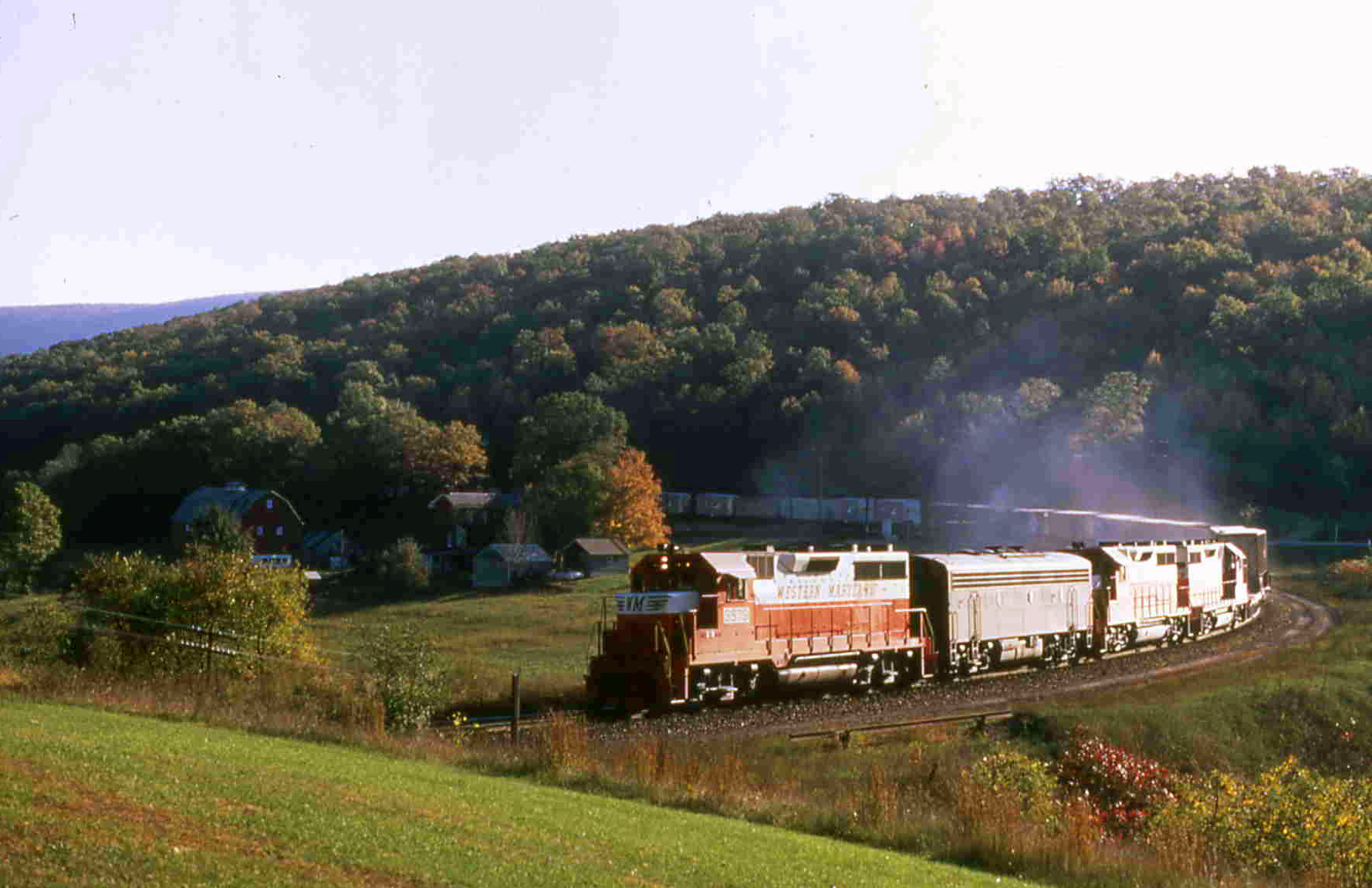 Western Maryland GP35 #3579, an F7B, and two other GP35s are on the point of one of the famed 'Alpha Jets' as the train heads westbound on October 18, 1970. Paul Kutta photo.
Western Maryland GP35 #3579, an F7B, and two other GP35s are on the point of one of the famed 'Alpha Jets' as the train heads westbound on October 18, 1970. Paul Kutta photo.Construction
To reach Connellsville, however, required the railroad to mostly build its own line as there was not one already constructed. The closest was the B&O's main line to Pittsburgh, which naturally was not an option. In 1910 construction began.
About seven railroad miles west of Cumberland and just outside of the small town of Corrigansville, Maryland engineers had to figure out how to span the Cash Valley which lay in front of them. To reach the adjacent hillside they decided on a 180-degree horseshoe curve that would ultimately be about a half-mile in length.
The project also required purchasing a right-of-way from the Helmstetter family, which owned and operated a farm at the location. Thanks to their approval the railroad was allowed to build the engineering marvel which would come to define it, Helmstetter's Curve.
Connellsville Extension
While the WM featured several incredibly scenic locations along its system, particularly the Thomas Subdivision, none compared to the location at Helmstetter's farm.
During the building of the curve engineers decided to span the Cash Valley with a series of light, wooden bridges. The rails were placed atop these structures and then slowly back-filled with dirt. The highest points of the curve were actually several dozen feet above the valley floor.
Overall, the location featured a ruling grade of 1.5% and directly westward after clearing the curve trains encountered Brush Tunnel. From Cumberland the area was about 400 feet higher in elevation and while B&O's Sand Patch grade offered a somewhat lower grade, particularly from its westbound approach, the WM's main line was five miles shorter thanks in part to the curve.
Completion
Soon after the Connellsville Subdivision opened in 1912 the line was double-tracked to not only handle freight demand but also passenger trains.
During the final days of the curve's double-track operations one could be treated to a thunderous sight of large Class M-2 4-6-6-4 Challengers charging up the curve towards Connellsville with others sometimes cut in the middle and the rear of the train such as Class J-1 4-8-4 Northerns or I-2 2-10-0 Decapods.
Much of the WM's freight moved westward towards the connection with the P&WV so the company used fast trains like the WM-1 and Alpha Jets to get traffic quickly to its destination, and abruptly made quick turnarounds with eastbound empties to start the process all over again.
Map
Abandonment
Photographers such as Bill Price and Bob Collins captured these types of scenes during the early 1950s just before the second track was removed a few years later as passenger services ended. In its place, the Western Maryland installed centralized traffic control, CTC, with block signals between Cumberland and Deal (just east of Sand Patch).
After CSX Transportation was created in the 1980s much of the WM system was deemed superfluous in favor of the nearby B&O, including the line to Connellsville (sadly, Mother Nature sealed the fate of the Thomas Subdivision after severe flooding washed out that line in many locations through West Virginia).
Western Maryland Scenic Railroad
Luckily, the section between Cumberland and Frostburg was saved by the Western Maryland Scenic Railroad when the state stepped in and purchased the property for tourism. Today, the WMSR is one of the most popular tourist trains in the country.
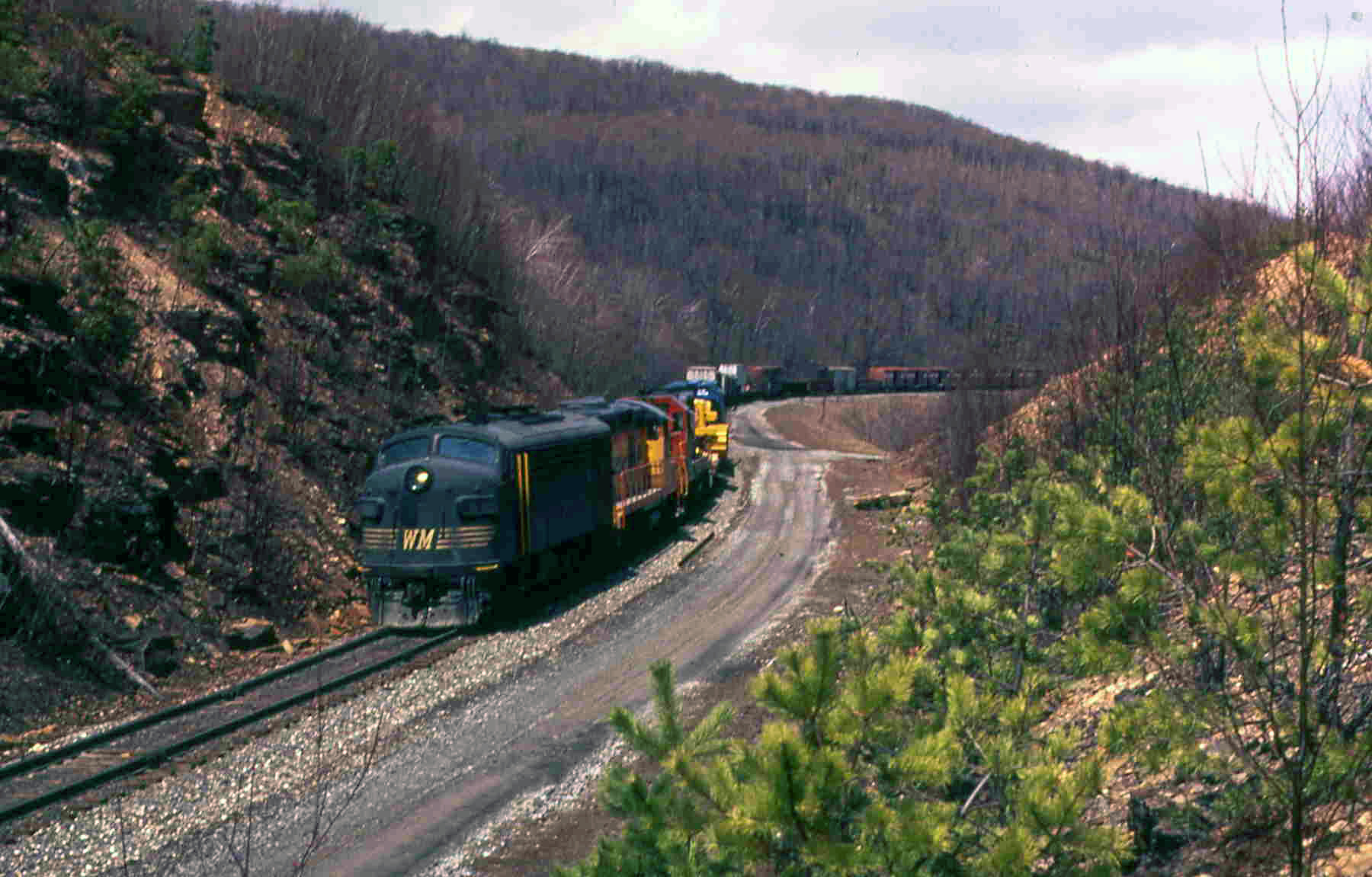 A Western Maryland freight led by an F7A and two Geeps (one in Chessie System livery and the other sporting the Circus scheme) near Helmstetter's some time during the 1970s.
A Western Maryland freight led by an F7A and two Geeps (one in Chessie System livery and the other sporting the Circus scheme) near Helmstetter's some time during the 1970s.For all of John Helmstetter's generosity over the years in allowing photographers to capture rail scenes on his property at the curve, unfortunately someone destroyed his iconic barn by arson in July, 2009, which had stood for more than 100 years.
Thanks to the efforts of railfans, the WMSR, and Steve Barry of Railfan & Railroad Magazine they formed the Helmstetter Farm Fund Committee to request donations in rebuilding his barn. It turned out to be quite the media sensation and resoundingly successful.
On November 12, 2009 with the help of several
Amish men from Pennsylvania the barn was rebuilt in a single day. Due
to all of this generosity, today, Mt. Helmstetter has a brand new barn
and continues to allow photographers access to his property.
Recent Articles
-
Texas Dinner Train Rides At The TSR!
Jan 19, 26 12:30 PM
Today, TSR markets itself as a round-trip, four-hour, 25-mile journey between Palestine and Rusk—an easy day trip (or date-night centerpiece) with just the right amount of history baked in. -
Iowa's Dinner Train Rides In Boone!
Jan 19, 26 12:28 PM
If you’ve ever wished you could pair a leisurely rail journey with a proper sit-down meal—white tablecloths, big windows, and countryside rolling by—the Boone & Scenic Valley Railroad & Museum… -
Ohio Dinner Train Rides At The CVSR!
Jan 19, 26 12:27 PM
While the railroad is well known for daytime sightseeing and seasonal events, one of its most memorable offerings is its evening dining program—an experience that blends vintage passenger-car ambience… -
Missouri's Dinner Train Rides In Branson!
Jan 19, 26 12:21 PM
Nestled in the heart of the Ozarks, the Branson Scenic Railway offers one of the most distinctive rail experiences in the Midwest—pairing classic passenger railroading with sweeping mountain scenery a… -
Virginia Valentine's Train Rides
Jan 19, 26 12:15 PM
If you’ve ever wanted to slow life down to the rhythm of jointed rail—coffee in hand, wide windows framing pastureland, forests, and mountain ridges—the Virginia Scenic Railway (VSR) is built for exac… -
Maryland Valentine's Train Rides
Jan 19, 26 12:12 PM
The Western Maryland Scenic Railroad (WMSR) delivers one of the East’s most “complete” heritage-rail experiences: and also offer their popular dinner train during the Valentine's Day weekend. -
Indiana's Dinner Train Rides In Jasper!
Jan 18, 26 01:54 PM
In the rolling hills of southern Indiana, the Spirit of Jasper offers one of those rare attractions that feels equal parts throwback and treat-yourself night out: a classic excursion train paired with… -
New Mexico's Dinner Train Rides
Jan 18, 26 01:37 PM
If your heart is set on clinking glasses while the desert glows at sunset, you can absolutely do that here—just know which operator offers what, and plan accordingly. -
New Hampshire ~ Murder Mystery ~ Dinner Train Rides
Jan 18, 26 01:10 PM
The state's murder mystery trains stand out as a captivating blend of theatrical drama, exquisite dining, and scenic rail travel. -
New York Valentine's Train Rides
Jan 18, 26 12:32 PM
At its best, the Adirondack Railroad delivers exactly what railfans and casual riders alike hope for: vintage coaches, classic depots, rivers and forests right outside the window. -
Washington Valentine's Train Rides
Jan 18, 26 10:50 AM
Whether you’re a dedicated railfan chasing preserved equipment or a couple looking for a memorable night out, CCR&M offers a “small railroad, big experience” vibe—one that shines brightest on its spec… -
Colorado Valentine's Train Rides
Jan 18, 26 10:49 AM
The Royal Gorge Route Railroad is the kind of trip that feels tailor-made for railfans and casual travelers alike, including during Valentine's weekend. -
Georgia Valentine's Train Rides
Jan 18, 26 10:42 AM
f you’ve ridden the SAM Shortline, it’s easy to think of it purely as a modern-day pleasure train—vintage cars, wide South Georgia skies, and a relaxed pace that feels worlds away from interstates and… -
New Jersey ~ Murder Mystery ~ Dinner Train Rides
Jan 17, 26 01:16 PM
There are currently no murder mystery dinner trains available in New Jersey although until 2023 the Cape May Seashore Lines offered this event. Perhaps they will again soon! -
West Virginia Dinner Train Rides In Elkins!
Jan 17, 26 01:08 PM
The D&GV offers the kind of rail experience that feels purpose-built for railfans and casual travelers. -
Virginia Dinner Train Rides In Staunton!
Jan 17, 26 11:55 AM
If you’ve ever wished you could pair a classic scenic train ride with a genuinely satisfying meal—served at your table while the countryside rolls by—the Virginia Scenic Railway was built for you. -
Florida Easter Train Rides
Jan 17, 26 10:23 AM
The cold weather rarely invades Florida and the state nearly always warm and balmy early spring temperatures. Learn more about where you can find Easter-themed train rides across the Sunshine State. -
Ohio Easter Train Rides
Jan 17, 26 10:13 AM
Ohio is home to several museums and excursion trains preserving the state's rich railroading heritage. A few of these locations host Easter-themed train rides each spring. -
Massachusetts Valentine's Train Rides
Jan 17, 26 09:58 AM
The Cape Cod Central Railroad (CCCR) blends classic New England scenery with heritage equipment, narrated sightseeing, and some of the region’s best-known “rails-and-meals” experiences. -
California Valentine's Train Rides
Jan 17, 26 09:53 AM
Operating out of West Sacramento, this excursion railroad has built a calendar that blends scenery with experiences—wine pours, themed parties, dinner-and-entertainment outings, and seasonal specials… -
South Carolina Dinner Train Rides
Jan 16, 26 11:13 PM
There is only location in the Palmetto State offering a true dinner train experience can be found at the South Carolina Railroad Museum. Learn more here. -
Rhode Island Dinner Train Rides
Jan 16, 26 11:01 PM
Despite its small size, Rhode Island is home to one popular dinner train experience where guests can enjoy the breathtaking views of Aquidneck Island. -
Pennsylvania's Thomas The Train Rides
Jan 16, 26 04:13 PM
"A Day Out With Thomas” train rides offer a unique opportunity for children and their families to engage in a magical and memorable experience, setting the stage for a full day of fun and adventure. -
Illinois's Thomas The Train Rides
Jan 16, 26 02:23 PM
In Illinois, the "A Day Out With Thomas" event offers a unique chance for families to immerse themselves in the enchanting world of Thomas and friends, creating memories that last a lifetime. -
New Jersey's Thomas The Train Rides
Jan 16, 26 02:11 PM
Here's a comprehensive guide to what you can expect at Day Out With Thomas events in New Jersey. -
Texas ~ Murder Mystery ~ Dinner Train Rides
Jan 16, 26 01:54 PM
Here’s a comprehensive look into the world of murder mystery dinner trains in Texas. -
Connecticut ~ Murder Mystery ~ Dinner Train Rides
Jan 16, 26 01:26 PM
All aboard the intrigue express! One location in Connecticut typically offers a unique and thrilling experience for both locals and visitors alike, murder mystery trains. -
New Hampshire Dinner Train Rides In N. Conway!
Jan 16, 26 10:47 AM
Tucked into the heart of New Hampshire’s Mount Washington Valley, the Conway Scenic Railroad is one of New England’s most beloved heritage railways -
Oregon Dinner Train Rides Near Mt. Hood!
Jan 16, 26 10:44 AM
The Mt. Hood Railroad is the moving part of that postcard—a century-old short line that began as a working railroad. -
Maryland's - Wine Tasting - Train Rides
Jan 15, 26 02:59 PM
This article delves into the enchanting world of wine tasting train experiences in Maryland, providing a detailed exploration of their offerings, history, and allure. -
Colorado's - Wine Tasting - Train Rides
Jan 15, 26 02:46 PM
To truly savor these local flavors while soaking in the scenic beauty of Colorado, the concept of wine tasting trains has emerged, offering both locals and tourists a luxurious and immersive indulgenc… -
Iowa ~ Wine Tasting ~ Train Rides
Jan 15, 26 02:36 PM
The state not only boasts a burgeoning wine industry but also offers unique experiences such as wine by rail aboard the Boone & Scenic Valley Railroad. -
Georgia's Wine Train Rides In Cordele!
Jan 15, 26 02:26 PM
While the railroad offers a range of themed trips throughout the year, one of its most crowd-pleasing special events is the Wine & Cheese Train—a short, scenic round trip designed to feel like a t… -
Indiana ~ Murder Mystery ~ Dinner Train Rides
Jan 15, 26 02:22 PM
This piece explores the allure of murder mystery trains and why they are becoming a must-try experience for enthusiasts and casual travelers alike. -
Ohio ~ Murder Mystery ~ Dinner Train Rides
Jan 15, 26 02:10 PM
The murder mystery dinner train rides in Ohio provide an immersive experience that combines fine dining, an engaging narrative, and the beauty of Ohio's landscapes. -
Nevada Dinner Train Rides In Ely!
Jan 15, 26 02:01 PM
If you’ve ever wished you could step through a time portal into the hard-working world of a 1900s short line the Nevada Northern Railway in Ely is about as close as it gets. -
Michigan Dinner Train Rides In Owosso!
Jan 15, 26 09:46 AM
The Steam Railroading Institute is best known as the home of Pere Marquette #1225 and even occasionally hosts a dinner train! -
Arizona's - Wine Tasting - Train Rides
Jan 14, 26 02:04 PM
For those who want to experience the charm of Arizona's wine scene while embracing the romance of rail travel, wine tasting train rides offer a memorable journey through the state's picturesque landsc… -
Arkansas's - Wine Tasting - Train Rides
Jan 14, 26 01:57 PM
This article takes you through the experience of wine tasting train rides in Arkansas, highlighting their offerings, routes, and the delightful blend of history, scenery, and flavor that makes them so… -
Tennessee ~ Murder Mystery ~ Dinner Train Rides
Jan 14, 26 01:42 PM
Amidst the rolling hills and scenic landscapes of Tennessee, an exhilarating and interactive experience awaits those with a taste for mystery and intrigue. -
California ~ Murder Mystery ~ Dinner Train Rides
Jan 14, 26 01:26 PM
When it comes to experiencing the allure of crime-solving sprinkled with delicious dining, California's murder mystery dinner train rides have carved a niche for themselves among both locals and touri… -
Illinois ~ Murder Mystery ~ Dinner Train Rides
Jan 14, 26 01:13 PM
Among Illinois's scenic train rides, one of the most unique and captivating experiences is the murder mystery excursion. -
Vermont's - Murder Mystery - Dinner Train Rides
Jan 14, 26 12:57 PM
There are currently murder mystery dinner trains offered in Vermont but until recently the Champlain Valley Dinner Train offered such a trip! -
Massachusetts Dinner Train Rides On Cape Cod!
Jan 14, 26 12:20 PM
The Cape Cod Central Railroad (CCCR) has carved out a special niche by pairing classic New England scenery with old-school hospitality, including some of the best-known dining train experiences in the… -
Maine Dinner Train Rides In Portland!
Jan 14, 26 11:31 AM
While this isn’t generally a “dinner train” railroad in the traditional sense—no multi-course meal served en route—Maine Narrow Gauge does offer several popular ride experiences where food and drink a… -
Kentucky Dinner Train Rides In Bardstown!
Jan 13, 26 01:14 PM
The essence of My Old Kentucky Dinner Train is part restaurant, part scenic excursion, and part living piece of Kentucky rail history. -
Kansas Dinner Train Rides In Abilene!
Jan 13, 26 12:44 PM
If you’re looking for a heritage railroad that feels authentically Kansas—equal parts prairie scenery, small-town history, and hands-on railroading—the Abilene & Smoky Valley Railroad (A&SV) delivers. -
Michigan ~ Murder Mystery ~ Dinner Train Rides
Jan 13, 26 11:24 AM
Among the lesser-known treasures of this state are the intriguing murder mystery dinner train rides—a perfect blend of suspense, dining, and scenic exploration. -
Virginia's - Murder Mystery - Dinner Train Rides
Jan 13, 26 11:11 AM
Among the state's railroad attractions, murder mystery dinner trains stand out as a captivating fusion of theatrical entertainment, fine dining, and scenic travel. -
Arizona Dinner Train Rides At The Grand Canyon!
Jan 13, 26 10:59 AM
While the Grand Canyon Railway does not offer a true, onboard dinner train experience it does offer several upscale options and off-train dining.

